Jog Falls
Jog falls in Karnataka is arguably the tallest waterfall in India. The river Sharavathi falls steep as it leaves the highland and enters the Konkan region, which is the coastal belt facing the Arabian Sea.
I
f you look at the topography of (south) India, the Western Ghats appears as a chain of mountainous stretch lying parallel to the Arabian Sea coast. Now on the east of Western Ghats is the Deccan Plane highland. On the west of Western Ghats is the narrow low lying coastal plane. That is the Konkan coast and the Malabar coast.The Western Ghats region gets one of the heaviest rainfalls, thanks to the monsoon. Obviously there are many rivers in the Western Ghats region. Any river that crosses the Western Ghats to the Arabian Sea direction has to make a steep fall.... somewhere. With water aplenty and a steep gradient in the geography, the region is home to many waterfalls. At place called Gersoppa , located near the western border of Shimoga district , the rocky mountain makes a 250 meter ( 820 feet) gorge. Now the river Sharavathi makes a dive over the cliff - you have the spectacular Jog Falls!
So what makes Jog Falls the Jog Falls?
Many things. As mentioned above , the height of it makes the important factor to its awe. There are many falls in India - at least 10 more - that are taller than the Jog. But a part of the Jog falls about 250 meters in one stroke, an unusual thing with the rest of falls that cascade. Guess what this portion of the Jog Falls earned the right nick name - Raja , the King.
The second point that adds to the beauty of Jog Falls is the shear volume of water that plunges down the gorge. A dam called Linganmakki , constructed about 6 kilometers upstream has restricted the flow of water. However during the monsoon season, the dam opens more water down the fall.
Another dimension the spectacle of the fall is panoramic style of the fall. Unlike the narrow single point of origin in the cases of most falls, Jog forms a series of distinctive falls. Just before the fall , Sharavathi spreads out and then head towards the center of an arc about half a kilometer long caved into the gorge. Together these series of adjacent falls (hence the name Jog Falls and not Jog Fall ) have a multiplication affect one each other. There are 4 easily distinguishable falls with fancy sounding names assigned.
Raja (King) on the left and Rani ( Queen) on the right extremity are so named for its characteristics. Raja makes an uninterrupted straight fall from the top to the base in one go. That is about quarter of a kilometer dive in one stroke.
Rani is in fact a cascading fall with spread as it reaches the base. This fall hits many rocky projections on its way down and makes and interesting spray and numerous mini falls. It's the most graceful of the all and hence called the Queen.
Between Raja and Rani are two other falls called Roarer and Rocket.
Roarer is located next to Raja. The curious name is given to it thanks to the sound it makes as water plunges down this stretch. As Roarer makes its dive from the top, it flow through a recess on the rocky wall of the gorge. The recess runs almost half way down and at an angle towards Raja. When water torrents through this constriction, it makes hell of a lot of sound compared to the rest of the three. When there is not enough water , this constriction that causes the sound can be easily seen from the viewpoint located close to the PWD guest house area ( about 2 km detour by road from the regular view point). A trek down from this point takes one to the point where Raja starts. Beyond it the terrain is treacherous and the river dangerous.
The Rocket is so called because of its trajectory.No insults intended to the rockets as this rocket plunges downward. Through a narrow constriction at the top , a huge quantity of water is made to pass. A jet results. It hits a few intermediate points before meet the pool at the base of the fall. Rocket is located next to Rani.
So that is about the who is who of Jog Falls.
What else makes Jog special ? Its uncluttered view points nevertheless. It appears as if the falls and the view points are well designed and orchestrated by nature. Think of a gigantic open theater and a gallery opposite to it with a panoramic view. That is exactly what the terrain is made of water falls from the steeper side of the gorge that makes an arc almost. Opposite to it is the view point , located almost a kilometer away but almost at the same level of the fall's top point. From this point the star of the fall appears to be at the eye level.
Now one can slowly trek down to the base of the fall, never losing the view of the fall as you decent. As you reach down the perspectives of the falls keep changing. The panoramic view from the top slowly give way to the torrent and the brute force of the river. The sound levels are high. So is the spray that makes one drench , long before the point where water hits the base.
What are all the strategies to tour Jog Falls ? Let us first see the options once you've reached the location. The route and travel options are discussed later.
There are two popular points ( actually three, is you are prepared to trek to the bottom of the fall ) near the fall a typical tourist can visit.
The popular one ( read as the crowded one) is where most of the infrastructure for the tourists are located. A giant viewing gallery facing the falls, parking lot , food stalls, guest houses , toilets , bus stand etc are located here. It's about a kilometer or so from the main road ( NH 206). A sign post and a huge hoarding right next to a bridge across Sharavathi river gives direction.
Trekking to the base of Jog Falls. At the end of the parking lot is the viewing gallery. As you face the fall , on your left , a minutes walk down the steps takes you to another view point. Most of the visitors are satisfied with these two viewpoints.
After a point the steps to the valley end. Then it is a trek on some hard trail to the base of the Jog Falls.
The enterprising ones however can take the steps down the slope. From the viewing gallery take the steps than zigzags down to the base of the fall. It can easily take an hour's trek to reach the base. Remember , the climb back is tedious and on top of it you are already tiered.
The steps are still under construction. After some point the steps end. From this point onward , the only way is the scramble through the rocky path. It's difficult if not impossible. At the base of the fall are two large pools, rather craters created by the falling water.
Once reached the valley, you need to again negotiate through a large number of giant boulders, some as big as a house, to reach the place where water hit the base. But that is on the other side of the crater mentioned above. Be mindful, it is a dangerous terrain with no help around. However tempting it is , better not to venture into water.
Look for the warning notice. For safety reasons sometimes it is not allowed to go to the base of the fall. More so when there is dangerously high level of water. Even other wise watch out for the broken glasses and other hostile things, those cheeky monkeys trying to snatch snack packets included.
During the peak season, the spray and force of water would allow one to reach even this point. It is almost impossible to precede further. There are a few makeshift stalls on the way down selling water and other cool drinks ( at a premium of course).
If you are trekking down never carry any avoidable items. Even a two liter water bottle seems too heavy beyond a point while trekking. Wear a good pair of shoes that gives good grip and protection. Carry a cap or hat. Though it is jam packed with trees, the sun can easily wear you out. Once in the valley , there is no shade anywhere.
Camera at Jog Falls? The water spray can create havoc with costly equipment. There is no place where you can safe keep it down there. Imagine you are getting into torrential rain. Carry some protective means for the camera.
The the Dharwar system. The boulders scattered at the base of the fall are one of the oldest and fascinating in its shapes. The awe of the fall is such that the otherwise beautiful boulder strewn terrain doesn't get its due mention anywhere.
The torrential flow of water eroded the face rock gorge into a vertical scoop. The blocks of rock thus fallen lies scrambled all around the base of the fall. Again water falls on the surface of the rock with brute force. This has been continuing for many thousand years. The erosion has created some interesting patterns on these metamorphic rocks. They look as if it has been made out of layers of thin rock sheets stuck together.
Wildlife at Jog Falls. If you are into birdwatching , this place won't disappoint you. The vertical face of the rock with its recesses is ideal nesting location for the bird life. If you are lucky , an Indian Giant Squirrel with its golden brown coat may just hurry across your path down to the water fall. Then there are the black faced langurs jumping around. They seems a bit more shy than their smaller cousins , the Bonnet Macaque. Hopefully a crocodile would not make a guest appearance, as you touch the water. Remember , you are somewhere in the northern fringes of the Sharavathi Valley Wildlife Sanctuary.
A mentioned earlier the another vantage point to view the fall is from the view point near the PWD guest house area. You need a private vehicle to reach this location. It's about 2 kilometers from the location where the local bus drop you. A road from the NH 206 goes around the hill and ends near the guest house area.
A series of steps along the edge of the gorge and a projecting balcony. You are now at the top edge of the gorge. A short trek further can take you the origin of the fall Raja.

Picture of Jog Falls shows the locations of the four falls called Raja , Rani , Roarer and Rocket.
Picture of Jog Falls shows the locations of the four falls called Raja , Rani , Roarer and Rocket.
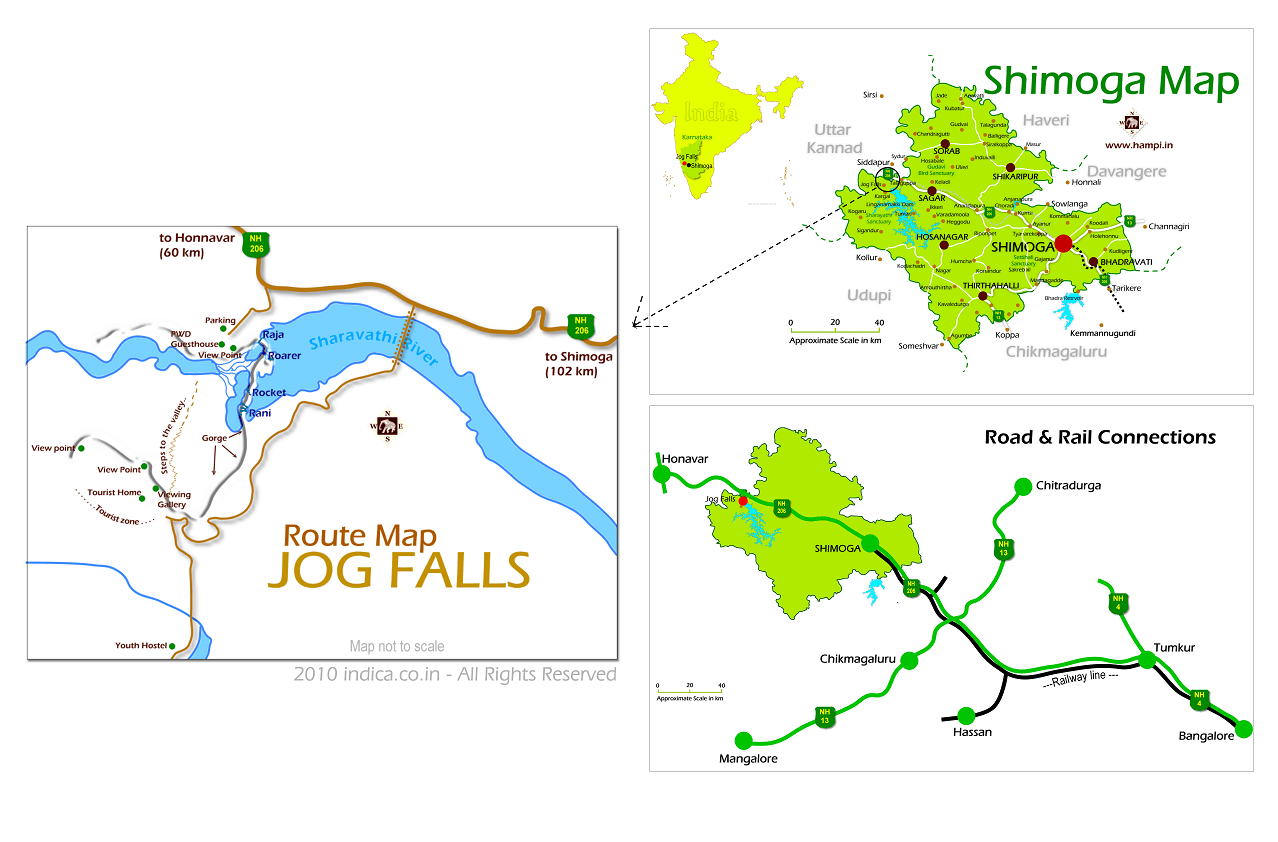
Route map for Jog Falls
Route map for Jog Falls. See also the detailed map of Shimoga.
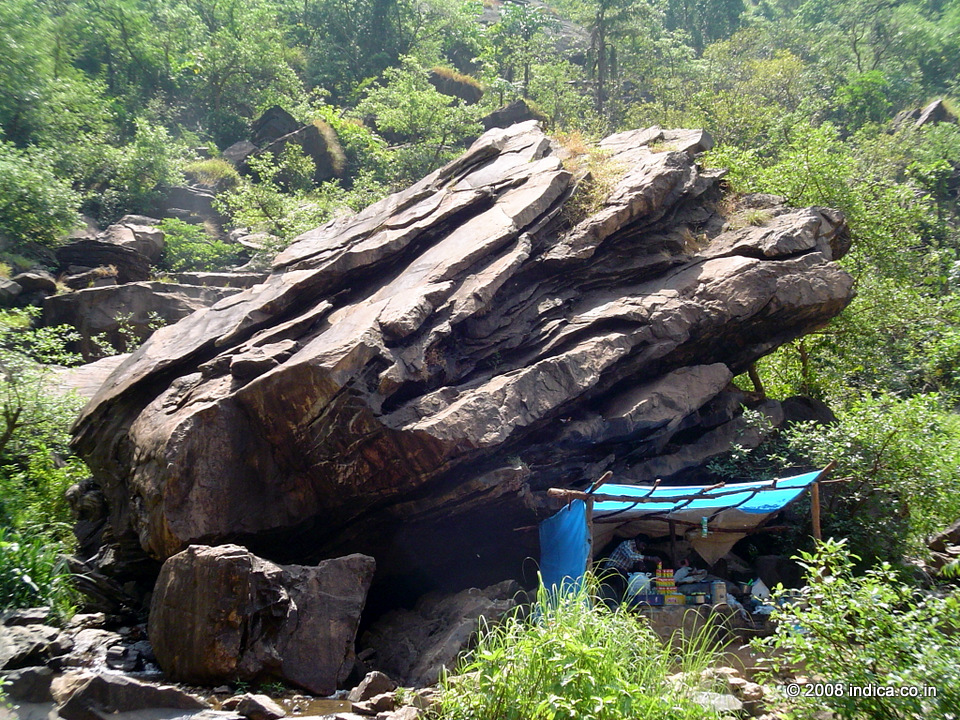
Makeshift Soft drink kiosk right at the base of the Jog Falls. Note that rock formation.
Makeshift Soft drink kiosk right at the base of the Jog Falls. Note that rock formation.
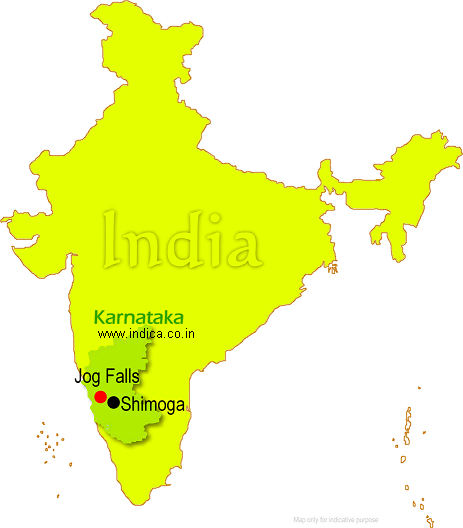
Location of Jog Falls
Location of Jog Falls
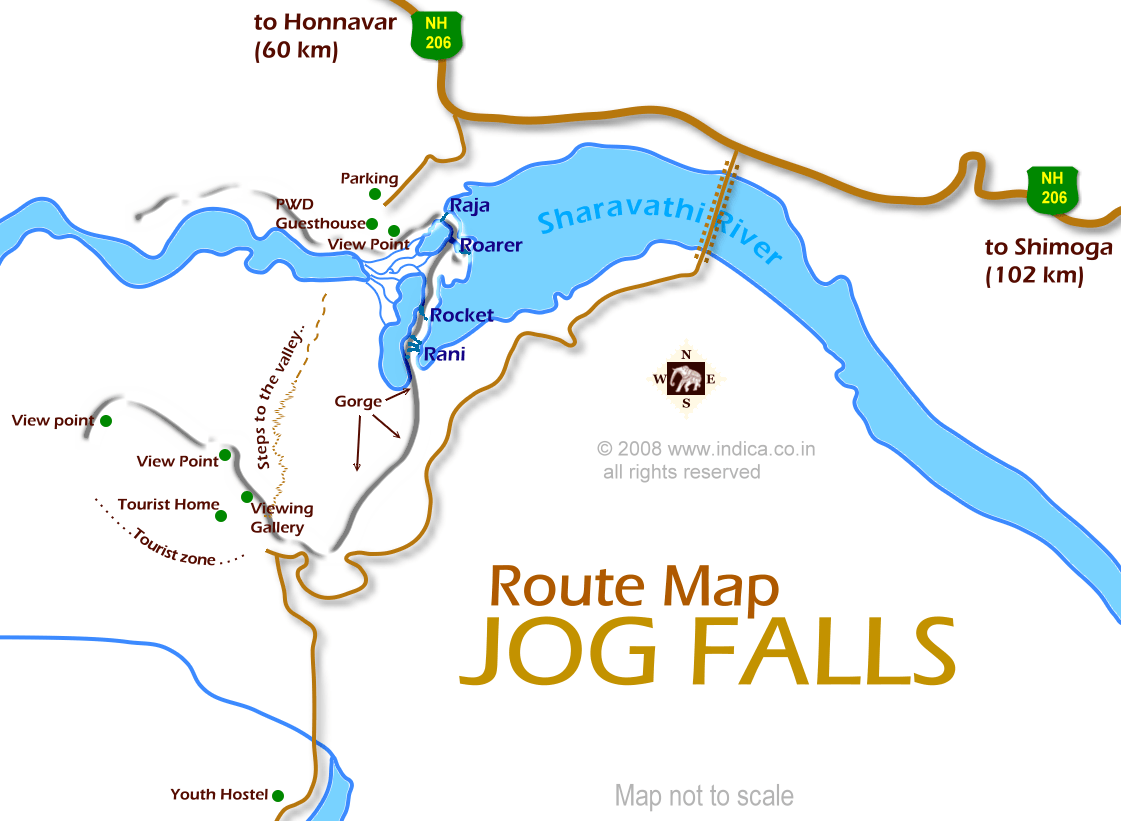
Map of Jog Falls near Shimoga. The map shows the locations of the four falls called Raja , Rani , Roarer and Rocket.
Map of Jog Falls near Shimoga. The map shows the locations of the four falls called Raja , Rani , Roarer and Rocket.
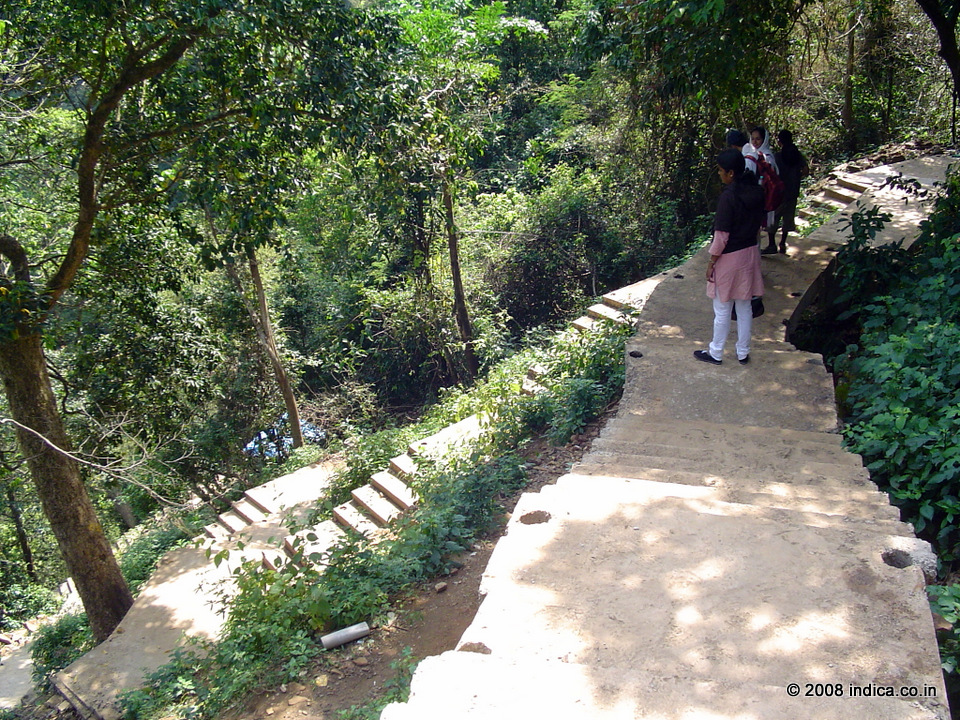
Trek path to Jog Falls. Beyond a point, the constructed steps ends, and you have to use the rocky trails to reach the base of Jog Falls.
Trek path to Jog Falls. Beyond a point, the constructed steps ends, and you have to use the rocky trails to reach the base of Jog Falls.
Soapstone sculptures
The beauty of the Hoysala templs , particularly its intricate carvings owes a lot to one material - Soapstone. Unlike granite, sandstone and marble used in the construction of most of India's ancient monuments, soapstone is softer with some peculiar properties that set it apar from the former materials. To give you an idea , the softer version of the soapstone can be carved even with your finger nail.
